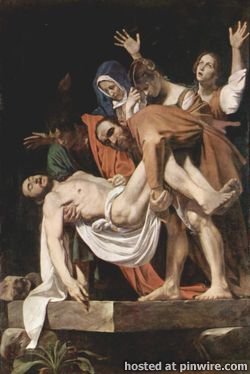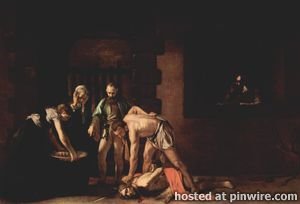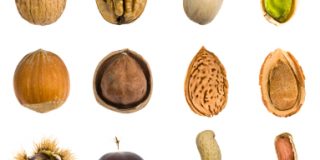Death and rebirth of a reputation
 The Entombment of Christ (1602-1603). Pinacoteca Vaticana. |
Caravaggio’s fame scarcely survived his death. His innovations inspired the Baroque, but the Baroque took the drama of his chiaroscuro without the psychological realism. He directly influenced the style of his companion Orazio Gentileschi, and his daughter Artemisia Gentileschi, and, at a distance, the Frenchmen Georges de La Tour and Simon Vouet, and the Spaniard Giuseppe Ribera. Yet within a few decades his works were being ascribed to less scandalous artists, or simply overlooked. Largely this was a matter of changing fashion — the Baroque, to which he contributed so much, had moved on. And partly it was due to critical demolition-jobs done by two of his earliest biographers, Giovanni Baglione, a rival painter with a personal vendetta, and the influential 17th century critic Giovan Bellori, who had not known him but was under the influence of the French Classicist Poussin, who had not known him either but hated his work.
In the 1920s art critic Roberto Longhi brought Caravaggio’s name once more to public attention, and placed him in the European tradition: “Ribera, Vermeer, La Tour and Rembrandt could never have existed without him. And the art of Delacroix, Courbet and Manet would have been utterly different.”[28] The influential Bernard Berenson agreed: “With the exception of Michaelangelo, no other Italian painter exercised so great an influence.”[29]
Modern Tradition
 The Beheading of Saint John the Baptist, 1608. Oratory of the co-Cathedral of St John, Valletta. |
Many large museums of art, for example those in Detroit and New York, contain rooms where dozens of paintings by as many artists display the characteristic look of the work of Caravaggio — nighttime setting, dramatic lighting, ordinary people used as models, honest description from nature. In modern times, painters like the Norwegian Odd Nerdrum and the Hungarian Tibor Csernus make no secret of their attempts to emulate and update him, and the contemporary American artist Doug Ohlson pays homage to Caravaggio’s influence on his own work. Filmmaker Derek Jarman turned to the Caravaggio legend when creating his movie Caravaggio; and Dutch art forger Han van Meegeren used genuine Caravaggios when creating his ersatz Old Masters.
Only about 50 works by Caravaggio survive. One, The Calling of Saints Peter and Andrew, was recently authenticated and restored. It had been in storage in Hampton Court, mislabeled as a copy. At least a couple of his paintings have been or may have been lost in recent times. Richard Francis Burton writes of a “picture of St. Rosario (in the museum of the Grand Duke of Tuscany), showing a circle of thirty men turpiter ligati” which is not known to have survived. Also, a painting of an Angel was destroyed during the bombing of Dresden, though there are black and white photographs of the work.



